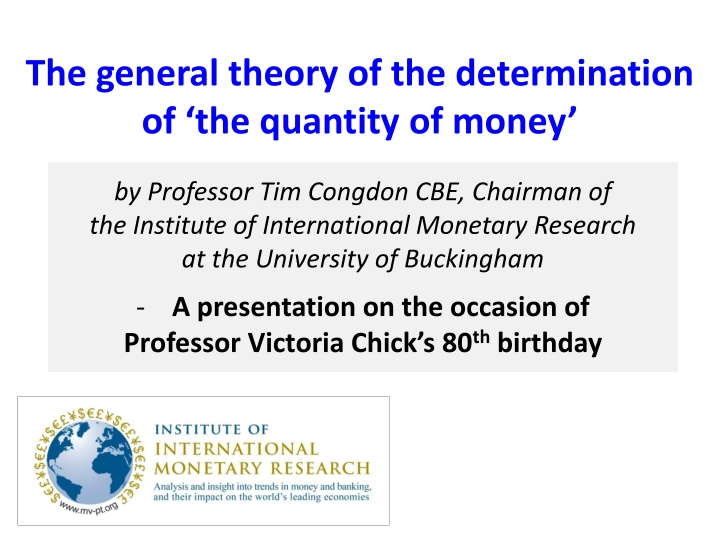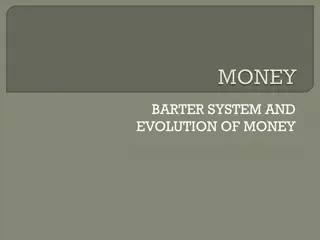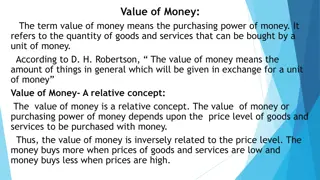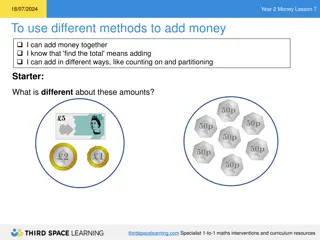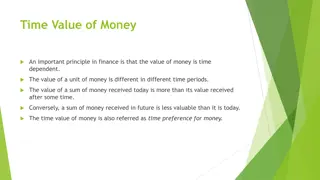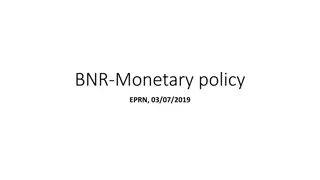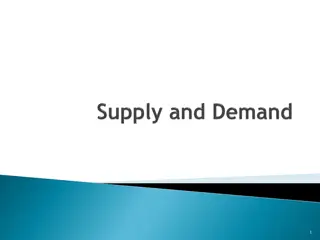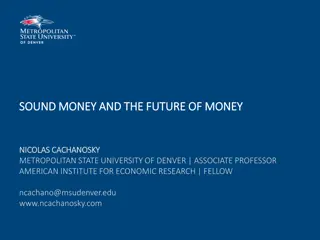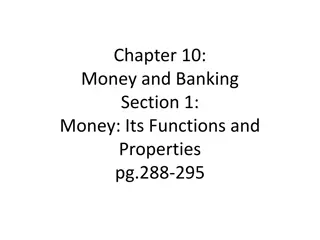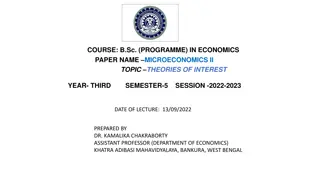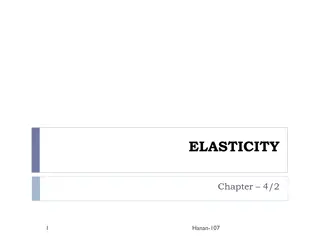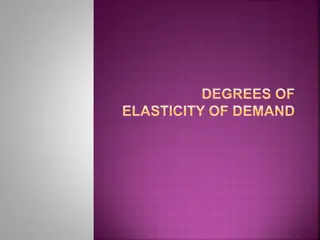The General Theory of Money Quantity Determination by Professor Tim Congdon
The rate of interest is influenced by time-preference, capital productivity, and monetary variables, as discussed by key economists like Keynes and Basil Moore. Keynes' Liquidity Preference Theory highlights the connection between money supply and demand. While the theory has strengths, it also faces criticisms for its assumptions and limitations, such as the inelastic money creation process and simplification of complex economic interactions. Basil Moore's horizontalism emphasizes the concept of infinitely elastic money supply.
Download Presentation

Please find below an Image/Link to download the presentation.
The content on the website is provided AS IS for your information and personal use only. It may not be sold, licensed, or shared on other websites without obtaining consent from the author.If you encounter any issues during the download, it is possible that the publisher has removed the file from their server.
You are allowed to download the files provided on this website for personal or commercial use, subject to the condition that they are used lawfully. All files are the property of their respective owners.
The content on the website is provided AS IS for your information and personal use only. It may not be sold, licensed, or shared on other websites without obtaining consent from the author.
E N D
Presentation Transcript
The general theory of the determination of the quantity of money by Professor Tim Congdon CBE, Chairman of the Institute of International Monetary Research at the University of Buckingham - A presentation on the occasion of Professor Victoria Chick s 80thbirthday
Theories of interest rate determination The rate of interest is a real phenomenon, determined by some combination of time-preference and the (marginal) productivity of capital. (Ricardo, Bohm- Bawerk, the neoclassical school ) The rate of interest is a monetary phenomenon, with the rate of interest determined when the demand for a monetary variable is equal to the supply of the same monetary variable. (Keynes, Basil Moore, the post- Keynesians) Subject has a relationship with general-equilibrium theorizing, if a very vexed relationship. The monetary theories tend nevertheless to be expressed in Marshallian terms, with supply-demand diagrams.
Keynes liquidity preference theory Increase in M from 1 to 2 lowers bond yield, but from 2 to 3 does not change rate of interest in this sense 'Rate of interest', in sense of the long bond yield Money supply function 1 2 3 Demand-to-hold -money function The quantity of money, in the sense of broadly-defined money (bank deposits)
Keynes liquidity preference theory - Strengths 1. The market-leader with a strong brand name. 2. It does equilibrate the demand to hold money with the quantity of money created by the banking system, surely a vital condition of macro- equilibrium. 3. Valid if banks assets contain no claims on the private sector, which is important if banks are not lending to the private sector (for whatever reason).
Keynes liquidity preference theory - Weaknesses 1. A general theory ? Rate of interest is long bond yield, not money market rate, quantity of money not distinguished from quantity of monetary base, and only non-monetary asset is the long bond. 2. The quantity of money (i.e., bank deposits) assumed to be determined by officialdom, with money creation process unaffected by rate of interest, and function inelastic and therefore vertical to the quantity-of-money x axis. Realism of this assumption is for debate. 3. The construct in Marshallian and partial-equilibrium in character. It takes position of money demand function to be fixed when the quantity of money is changing, but this too is for debate. The construct handles levels of the two variables, not rates of change.
Basil Moores horizontalism Money supply function infinitely elastic because of overdrafts , but M fixed by intersection with money demand [demand for credit] function 'Rate of interest', in the sense of a rate relevant to bank credit 'Demand for money function', meanng 'demand for credit' Money supply function, taken to be an infinitely elastic supply of bank credit at any interest rate 1 2 In his 1988 book Moore has diagrams for both bank money and the base. The quantity of money, in the sense of broadly-defined money (bank deposits), which approximates quantity of bank loans
Basil Moores horizontalism Money supply function infinitely elastic ( overdrafts ), but M fixed by intersection with money demand [demand for credit] function Loans create deposits and deposits make reserves - Strengths 1. Consistent with bankers view of their own business and with widespread availability of overdrafts for their corporate customers. 2. Suggests that central banks operate not by controlling quantity of base/reserve assets, but by changing the money market rate, and this also has merit of realism.
Basil Moores horizontalism - Weaknesses 1. Equilibrium between Md and Ms always achieved by change in the money supply. Implicit flat denial that macro outcomes can be affected by attempts to remove excess/deficient money balances with bank credit given. 2. Moore in effect denies that that the notion of the demand to hold money has any significance. His money demand function is not about the demand to hold money, but is a demand for bank credit function. Unsatisfactory if banks assets mostly government securities.
Our wish list Market in base money, the money market , with only central bank and commercial banks - Equilibrium should be on both sides of the central bank balance sheet, - Demand for central bank credit should be equal to quantity of such credit extended by the central banks, and - Demand to hold base money by commercial banks should be equal to quantity of base money created by the central bank (and not held by non- bank public). Equilibrium in money , in bank deposit sense, with commercial banks and non-bank private sector agents (people, companies) - Equilibrium should be on both sides of commercial banks balance sheets, - Demand for bank credit should be equal to quantity of credit extended by commercial banks, and - Demand to hold bank deposit money should be equal to quantity of such money created by the banking system.
Equilibrium of central bank credit and base money Determination of quantity of central bank credit and the central bank rate ('discount rate', etc.) Central bank rate, r r Banks' demand-for-central-bank-credit function r 1 Horizontal supply schedule 3 2 1 R 1 45 degrees Central bank credit, quantity Inter-bank rate, R Monetary base, held by banks, qty. Banks' demand-to-hold- base function 3 4 5 Central bank capital, etc. , plus , in the real world, non-bank public's note holding Vertical supply schedule Determination of quantity of banks' cash reserves and the inter-bank rate
Equilibrium of commercial bank credit and the quantity of money Determination of quantity of commercial bank credit and the bank lending rate Bank lending rate, r r Non-banks' demand-for-bank-credit function r 1 Horizontal 'overdraft' supply schedule 3 2 1 'The rate of interest', in Keynes' sense, R R 1 45 degrees Commercial bank credit, quantity Quantity of money, broadly-defined Demand-to-hold- money function 3 4 5 Banks' capital and other non- monetary liabilities Vertical supply schedule Determination of quantity of money and Keynes' 'rate of interest'
The ideas at work Market in base money, the money market - Identity between both sides of the balance sheet delivered by trick of 45 degree lines. - Horizontalism applies in market for central bank credit. - Verticalism applies in inter- bank market for base money, = base money to hold Note that central banks can conduct a wide range of operations, including auctions of base money and last-resort loans. Market in bank money (i.e., deposits), quantity of money - Identity between both sides of the balance sheet delivered by trick of 45 degree lines. - Horizontalism applies in market for commercial bank credit. (Credit spread can be fixed by bringing in bank capital.) - Verticalism applies in quadrant where demand to hold money is equal to quantity of money created by banks. (This quadrant represents Keynes liquidity preference theory of rate of interest , which brings us back to the textbooks.)
Horizontalism and structuralism But is it entirely realistic to posit a horizontal supply curve of bank credit? (The overdraft, and its benefits for customers with volatile balance sheets.) Most overdrafts specify a maximum, which if exceeded cause a large step-jump in the interest margin or result in the lending bank simply not honouring the instruction. At an individual level, the horizontal line stops etc. At an aggregate level, as the various overdraft maxima kick in, the supply-of-credit curve slopes upwards to the right beyond a certain point. In a typical cycle, banks start to strain against capital ceilings if loan demand is very strong, and they may widen margins. But surely that is a shift in the supply-of- credit curve between two or more moments in time.
Does the aggregate supply-of-credit function slope upwards to the right? Yes, after a point, but only in emergencies (heavy loan drawdowns in panics) , in practice Rate of interest', in sense of cost of bank loans Supply-of-bank-credit function Demand-for-bank-credit function x Quantity of bank loans/Quantity of money
Existing four-panel/four-quadrant treatments of the subject Brunner and Meltzer 1966 A very different diagram, with both base multiplier determining deposits, and earning assets determining deposits, and the base split between base held by banks and non-banks. (I ignore non- bank cash, as uninteresting.) B & M have separate diagram equating demand for bank credit with supply of loans, which introduces an interest rate. Process of money creation said to be endogenous . Fontana 2003 (or 2004) Again, a very different diagram, with a. bank reserves and deposits both having axes and linked by base multiplier, b. deposits also equal to bank loans, with c. the interest rate equilibrating demand for loans with loan supply, represented by a line horizontal to the x-axis. Equilibrium involves reserve market , credit market and financial market , but same diagram used three times.
Four-panel/four-quadrant treatments of the subject What is the value of these approaches? We can represent concisely equilibrium of both the banking system (esp. determining the quantity of money, broadly-defined, please) and the non-bank private sector, that both borrows from banks and must hold the deposits the banking system creates. My approach enables horizontalists ( money is endogenous ) and verticalists ( exogenous )to talk to each other! An attempt at generality and indeed reconciliation.
Do we want a general theory of the determination of the quantity of money (and the rate of interest)? Thus one concludes that money is neither purely exogenous nor purely endogenous. Which is the better description depends on circumstances. - Victoria Chick Macroeconomics After Keynes, p. 236 of the MIT Press Classic edition
